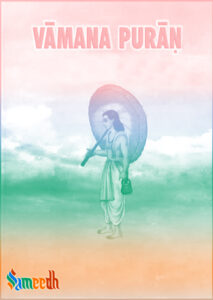The Vamana Puran is indeed one of the eighteen Mahapuraṇs in Hinduism. This Puran primarily focuses on the Vamana Avatar (dwarf incarnation) of Lord Vishnu and provides various mythological stories, legends, and religious teachings. The Vamana Puran contains details about the creation of the universe, genealogies of deities, legends associated with different regions and pilgrimage sites, and discussions on rituals and dharm (righteousness).

The Puran begins with the sage Narada approaching Lord Sanatkumara and expressing his desire to learn about the Vamana Avatar of Lord Vishnu. Sanatkumara then narrates the Puran to Narada. Like many other Purans, the Vamana Puran describes the creation of the universe, the origin of various deities, and the cosmic cycles of creation and destruction.
The Mahapuraṇs includes genealogies of gods, sages, and kings. It provides details about various dynasties, their rulers, and their contributions to the world. The text contains a variety of mythological stories, including tales of gods, goddesses, and legendary characters. These stories often convey moral and ethical teachings.
The central theme of the Vamana Puran revolves around the story of Vamana Avatar, where Lord Vishnu incarnates as a dwarf Brahmin to subdue the demon king Bali and restore balance to the universe. The narrative explores the significance of devotion, the consequences of virtue and vice, and the cosmic order (dharma).
The exact origins of the Vamana Puran, like many ancient religious texts, are challenging to determine with precision. Purans in Hinduism are believed to have been composed over a long period, with contributions from multiple authors across different centuries. The Vamana Puran, like other Purans, is traditionally attributed to the sage Vyasa, who is also credited with compiling the Vedas and composing several other Purans.
These texts were likely composed through a process of oral tradition before being transcribed in written form. The dates of their composition can vary, and they are often classified into different periods. Scholars believe that the Purans, including the Vamana Puran, were composed over a span of several centuries, with some portions possibly dating back to the early centuries of the Common Era.
The story begins with the birth of Vamana as the son of the sage Kashyapa and his wife Aditi. Aditi, the mother of the gods (Devs), seeks the help of Lord Vishnu to protect the Devs from the oppression of the demon king Bali. King Bali, also known as Mahabali, was a virtuous and powerful ruler. His virtues and austerities earned him immense power, and he became the ruler of the three worlds, displacing the Devs. Despite being a demon, Bali was known for his generosity and adherence to Dharm.
In an effort to curb Bali’s power and protect the Devs, Lord Vishnu takes the form of Vamana, a dwarf Brahmin. Vamana approaches Bali, who is performing a grand yajna (sacrifice), and asks for a seemingly modest gift – three paces of land. Bali, known for his generosity, agrees to grant Vamana’s request. However, as soon as Bali agrees, Vamana transforms into a gigantic form, covering the entire universe in three steps. With his first step, Vamana covers the earth; with the second step, he covers the heavens. With no space left for the third step, Bali offers his own head for Vamana to place his foot.
Impressed by Bali’s sacrifice and unwavering devotion, Vamana grants him a boon. Bali requests to visit his kingdom once a year. Lord Vishnu grants this request, allowing Bali to rule the netherworld.
This story is significant in Hindu mythology as it illustrates the concepts of dharma (righteousness), devotion, and the inevitable victory of virtue over vice. It is also a tale of the benevolence of Lord Vishnu and the complexity of moral choices.
The Vamana Puran concludes with the sage Sanatkumara imparting spiritual knowledge to Narada, emphasizing the importance of devotion and righteousness. It’s important to note that the Vamana Puran, like other Purans, serves multiple purposes, including preserving cultural and religious traditions, providing moral teachings, and explaining the mythology of Hinduism.